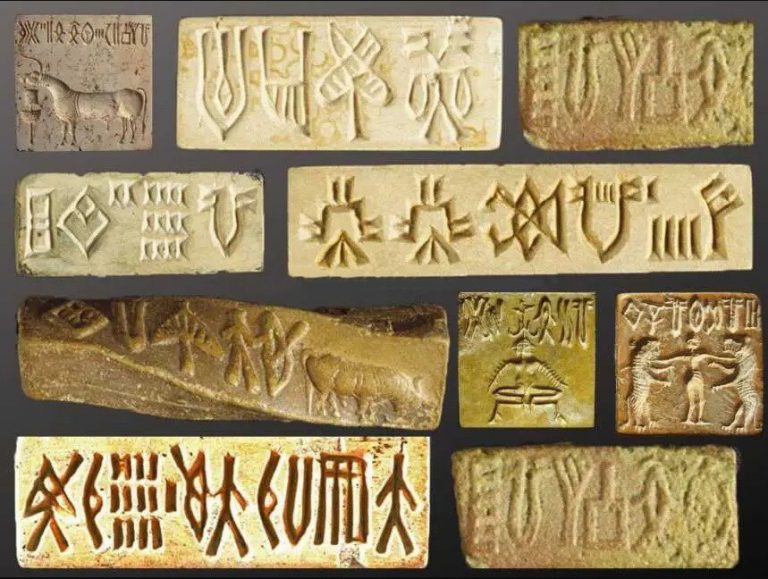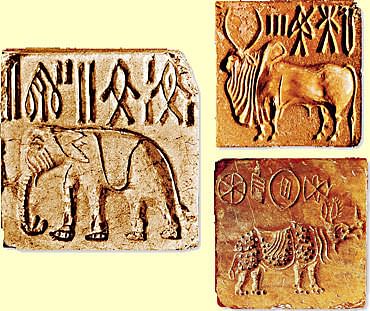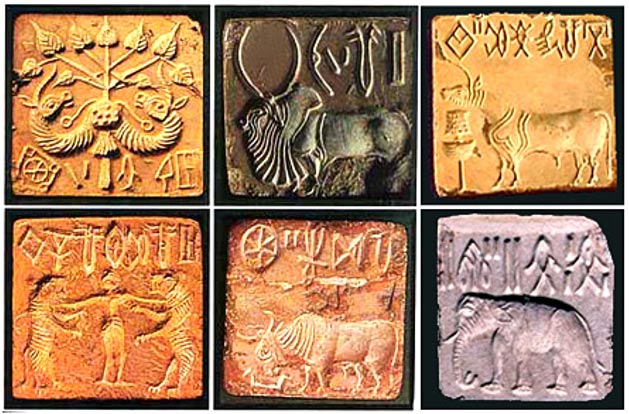
Many earlier excavators did not record the context in which seals were found, so one cannot assess whether they were in secondary deposits or primary deposits.
[The present research deals with Indus Script; Indus valley civilization. The Indus script invented before 2600BC, reflect the fundamental changes in social, political and ritual organization that accompanied the formation and consolidation of cities, when the first inscribed era of economic and political hegemony that would last 700years.This paper also tries to find out where the script was emerged, deciphering dilemma and trying to understand how the script was used and possibly why it disappeared.]
Quratulain Mirbahar
Uses of Indus Script
Indus script used through means of Seals, tablets and Copper tablets. Although adaptation of the script may have taken several generations. Eventually, artisans used seals or wooden molds to produce numerous copies of inscriptions or narrative scenes on fired terracotta and glazed faience tablets. Potters used seals to impress the writing on pottery vessels, usually the disposable drinking cups. Artisans and workers, who may have been illiterate, produced these and other examples of the script, using or copying signs that they could not read. Many scholars would agree that the people who used these inscribed objects and read the messages encoded in the signs were the people who controlled the city administration. Some seals may have been used by religious leaders for special ceremonies and other was used by the landowners or traders. In all of the major settlements the literate elites, ritual specialists, merchants or land owners used writing many different contexts in the home and at work.
On personal ornaments and ritual objects as well as on trade goods. It appears to me that they were comfortable enough with the writing to scribe messages to each other on pottery vessels and write names or protective charms on to wet clay vessels or sealing. Some literate individual who travelled to distant lands carrying their seals but so far no seals or impressions with foreign writing have been found in the Indus valley. Through careful study scholars understand the role it played in the Indus society. The Indus script was carved, incised, chiseled, inlaid, painted, molded and embossed on terracotta and glazed ceramic, shell, bone, and ivory, sandstone, steatite and gypsum, copper and bronze, silver and gold. Script was also woven on to fabrics and basketry, carved into wood, inscribed on to palm leaves and possibly painted on the human body, all perishable materials. The wide variety of materials and techniques involving the Indus script is unparalleled in the third millennium BC. In most script was written from right to left as in practice in Semitic script such as Arabic or Hebrew, longer texts that comprised more than one line were sometimes written in alternating direct called Boustrophedon, when the first line proceeds from right to left and the next line reads from left to right. While this reversibility is confusing for archaeologists and linguists, it may have been normal for the people who were writing and using the script. Indus script found on seals some time square and rectangular made from fired steatite are most extraordinary category of object. The soft soapstone was carved, polished and then fired in a kiln whiten and harden the surface. This hard outer surface is commonly referred to a glazed. Seals made of metal are extremely rare, two seals made of silver with unicorn motifs and script were found at Mohen Jo Daro and animals have been found at lothal and the site of Ras al Junayz in Oman.

Animals depicted on seals usually males include domestic and wild animals as mythical creatures such as the unicorn. Some seals contain more complex iconography scenes that represent mythological or religious ever many large seals kept in Pouch. The smaller seals could have been hung from the waist or worn around the neck without much inconvenience. A lost seal with the writing and animal motif intact could be used by anyone for any purpose like a credit card today. In Mesopotamia there was punishment to use illegal seals or seals lost by owner, but we don’t about Indus seals. Although change in design suggests that they did change the design of the seals so they would not snap off easily.
Long rectangular seals had a hole drilled from the side across the middle of the seal, even occasionally broke in two pieces along the drill hole. A seal that was broken in two would have been useless, and most of the seals, we have found in the streets of the cities may have been broken intentionally so that they could not be the rescued illegally. The complete seals we find in the streets almost always are missing the boss. It is also observed that people occasionally lost their seals while walking or riding through the city, best that they usually broke the seals when they were no longer useful or buried them in their homes for safekeeping. No seal has even been found with a human burial. Change in rectangular seal shape resulted in the elimination of the central animal motif. This type of seal is found with only abstract writing. Which radically altered communication? Impressions made by the square seals carry two distinct messages. One is presented in the script that could only be understand by a literate workers delivering bundles of goods stamped with animal motif could very easily perceive who the owner were and which boats they should be taken to. The specific message in the written would verify to a literate merchant who the exact owner was. Rectangular seals on the other hand could only have been used to communicate with literate trading partners. Little sealing from long rectangular seals have been found, perhaps these seals were not used in everyday trade but had a different function. These two types of seals may represent a chronological change in seal styles, but this has not yet been confirmed.
Another use of writing can be seen on miniature tablet made of incised steatite, molded terracotta or faience. These tablets have an animal motif on one side and writing on the other. Numerous duplicates of the incised steatite tablets made from a single mold. The writing usually consists of a short inscription on one side and numerals on other side. Tablets that do have numbers on one side may represent some accounting system. The Indus tablets may have been used as tokens, made up in advance and distributed when goods were brought into the city as tribute or for sale. Thus tablets appear to have been used exclusively in larger cities, because only one or two example found from smaller settlement like lothal, Chanhu jo daro, Kalibangan and Rapar. But the discovery of workshop where these tablets were made would be a major breakthrough and would help to interpret their function. Rectangular copper tablets with incised writing and animal motifs are found almost exclusively at Mohen jo Daro reverse side of copper tablets usually has an animal or geometric motif. The only eight inscribed copper tablets found at Harappa are made with raised script, using a different technique one tablet that has several copies shows a hunter with a bow wearing a horned head dress, similar to those on figurines and carved on some of the seals. Copper tablets have intrinsic value. They can be re-melted and used to make other tablets or tools. Many copper tablets at Mohen jo Daro are approximately the same size and weight and may represent an attempt to create a standard currency or medium of exchange. The fact that these tablets are not found outside of Mohen jo daro indicates that they were limited to interactions and communications at the site alone and not on a regional scale. One of the least studied but potentially most informative contexts for writing is on pottery. Who came to the workshop specifically to write on the unfired pottery? Inscriptions made after firing, referred to as graffiti large black- stripped storage jars invariably have bold graffiti on the curving shoulder of the vessel often written at an angle as if the writer did not care how it looked.
The inscriptions probably represent the owner’s name, the vessel contents, or the destination. Parallel lines are often scratched onto the rims of the jars of different sizes, but there is no correlation between the number of lines and size of the vessel. Perhaps they represent how many measures of grains, oil or beer were poured into the jar, or they may indicate the number of times a jar has been refilled and emptied into another container. Inscriptions scratched on to a vessel in use reflect the practical application of writing in the course of active transactions. The traders and consumers of these specific goods must have been able to read and write or at least recognize specific symbols. One of the most exciting discoveries of the use of script resulted from the most re-examination of gold ornaments excavated from Mohen jo Daro in the 1920’s.
A large collection of gold objects with minute inscriptions that probably represent the names of owner scratched on to the polished surface. All inscriptions appear to have been made by the same sharp, pointed tool by the same hand. These inscriptions are extremely important because they are clearly different from the types of inscriptions found on the large copper Celts and Chisels. On copper or bronze tool, the writing appears formal. Beyond the commercial and personal uses of writing the Indus script appears to have had protective or magical powers. The repetition of specific signs at many different sites suggests that some signs were probably not personal names, but may have had some ritual significance. Other ritual uses of the script occur in conjunction with narrative scenes of what are probably rituals involving deities and powerful spirits. Short inscriptions associated with this scene may represent the names of deities, constellations, or supernatural events.
Disappearance of Indus Script
Rapid disappearance of the script by 1700BC demonstrates that writing was used exclusively by a small but powerful segment of the population and did not play a critical role in the lives of the common people. The script disappeared when the elites who used this means of communication in trade and ritual were no longer dominant. The seal carvers lost their jobs and eventually when new elites emerged writing was not important. After the Indus Script disappeared, between 1900BC and 1700BC there was no reason to invent a new script.
Deciphering Dilemma of the Indus Script
Deciphering the Indus script is not an easy task, there must be some parameters or assumptions to be establish in order to decipher it. If script is logo syllabic then it cannot be deciphered as an alphabetic or syllabic script. Because a logo syllabic script can only be deciphered if the language that it represents is known. Most scholars agree that Indus script belongs to Dravidian language family, sometime at present no language can be traced to Indus script. Over twenty-five Dravidian languages are presently spoken in the subcontinent including Tamil, Telegu, Kannada and Malayalmi. A branch of north Dravidians called Brahmi is still spoken in Baluchistan and Southern Afghanistan, not all scholars agree with the Dravidian identification. Today, several different major languages are spoken in regions. If individuals who spoke these languages moved to Indus valley and become established as merchant or landowners, their names and names of their deities may have been written on using the Indus script. There were no doubt many different dialects spoken throughout the Indus valley. Although it is possible that the Indus script represents the formal language spoken by elites, some names and words could reflect local dialects that varied from region to region. Consequently, if the writing on the seals does represents more than one language or dialect, we cannot decipher it until a bilingual text or a dictionary has been discovered. If Proto- Dravidian is the major language component of Indus Script, we can take a second step by isolating root words that shared by all of the various Dravidians languages. Thus root words represent hypothetical languages called Proto Dravidian. From which all of the various Dravidian languages evolved. Root Words that refer to a concrete concept can be represented by a picture of that object but abstract concepts must be communicated phonetically by using pictures of objects whose names could be combined to produce the intended word. This technique of communication is based on the Rebus Principal and the most common English example is the use of the symbol “bee” and “leaf” to create the word belief. The rebus principal was also used by Egyptian and Mesopotamian.

Proto-Dravidians root words were originally monosyllabic. Using the rebus approach scholars have identified key words that represent the general meaning of specific Indus signs. The most Convincing example is the fish sign. The Dravidian root for fish is “min” and the same word means “to glitter “flash or shine “the fish sign combined with six single-strike is very common in the Indus writing and it could be translated as “arumin” or six stars. Which would represent the constellation Pleiades? Another common occurrence is the fish sign with seven strokes, in Dravidian this would translate as “elu-min” or seven stars. Which is the name for the constellation of seven sages (ursa major or the big dipper). Although these interpretations sound convincing, the rebus approach can only be useful when there is some way to check and confirm the meaning or the grammatical sequence of the words. An example that illustrates some of the problems in trying to decipher language using this approach is “eye-heart-apple” as meaning I love the big apple. Without knowing the proper sequence of the words or that apple should be read : big apple “ and that big apple is another name for New York , the signs eye heart apple could just as easily be read , I love apples, apples love eye, eyes blood apples , or by using only the first letters of the words eye- heart- apple. EHA and reverse would be the next best thing to finding a bilingual text. Unfortunately no long texts have been found. If they were written on Palm leaf manuscripts or parchments they would not have been preserved in the humid climate of the Indus valley, over fifty different claims at decipherment have been published. But none of them meets the stringent requirement of the General Academic Community. For the present we cannot check the proposed interpretations and however logical or convincing they may be they do not represent a decipherment.
Conclusion
The Indus script invented around 2600 BC reflects the fundamental changes in social, political and ritual organization that accompanied the formation and consolidation of Indus valley civilization. Indus script can be found on seals used by elites, merchant, landowners and traders for authority purpose and these people could only read the messages encoded in signs and they also controlled the Indus valley administrations. The Indus script was carved, incised, chiseled, inlaid, painted, molded and embossed on terracotta and glazed ceramic shell, bone and ivory, sandstone, steatite and gypsum, copper, and bronze, silver and gold. Indus script considered as logo syllabic script, which was written from right to left like Semitic scripts. The script disappeared when the elites who used this means of communication in trade and ritual were no longer dominant many attempts done for the decipherment but not one proved convincing even though we may never know the specific meaning of the script or who could read and write. The scripts represent a shared set of symbols and beliefs that was spread out over an extremely large geographical are these shared beliefs must have played an important role in the integration of the urban and rural populations obtained through trade or created by new technologies. (Concludes)
__________________
The author is Teaching Assistant, Department of Anthropology & Archaeology University of Sindh Jamshoro.
Click here for Part-I